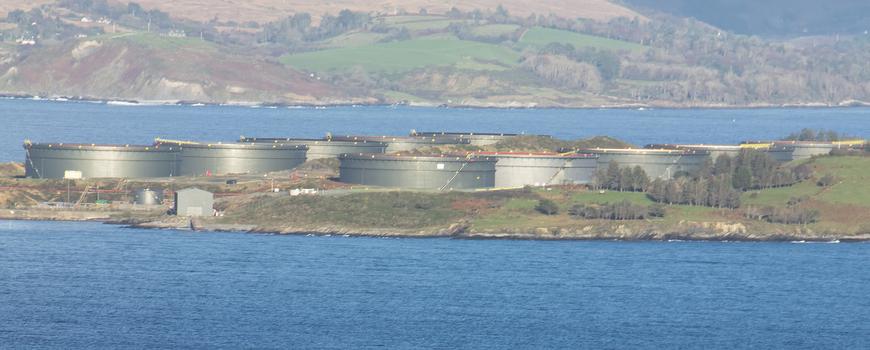
The Bantry Bay Terminal, Co. Cork, Ireland was constructed in the 1960s by Gulf Oil and has a nominal storage capacity for 1.3 million cubic meters of crude oil and petroleum product. Ownership was transferred to the Irish Government in 1986. At the time of the first Gulf War, an emergency project was undertaken to import 185,000 cubic meters of crude oil to be held as a national strategic oil reserve. In 1995, the then Minister for Transport, Energy & Communications sanctioned the construction of a single point mooring (SPM) with associated sub-sea pipelines to enable a facility for:
- The storage of national strategic reserves.
- The storage of offshore oil.
- The commercial storage of oil.
This was installed ~1,600 m offshore from the terminal and was commissioned in 1998, when two shipments of crude oil were imported to the terminal. In 2001 the terminal returned to private ownership and today it is used for the storage of crude oil and other petroleum products.
Recommissioning of facility
Byrne Ó Cléirigh has supported environmental, risk and sustainability initiatives at the terminal since the 1990s. We were originally appointed as consultants to help obtain the various permits and licences required to recommission the facility. These included:
- Planning permission
- Foreshore lease
- Bulk storage licence
- Jetty consent
- Trade effluent licence
We also assisted the Terminal in complying with the conditions set out in its foreshore lease and planning permission. One of these conditions required an environmental monitoring programme for Bantry Bay to be prepared to the satisfaction of the then Department of the Marine & Natural Resources and other relevant stakeholders, including the local mariculture industry, Cork County Council, the Marine Institute and An Bord Iascaigh Mhara. We prepared a comprehensive programme which required the chemical analysis of mussels & marine sediment, water column analysis, mussel taste testing and the surveying of annual seed mussel densities. Since then, we have managed and coordinated this programme on the terminal’s behalf and reported its results annually to the relevant stakeholders.
Environmental permitting
In 1999, the terminal’s activities came under the Environmental Protection Agency (EPA) Act and we prepared its application for an integrated pollution control (IPC) licence. Since then we have undertaken the following work streams to maintain compliance with the licence:
- Engagement with the EPA
- Annual study on fugitive emissions
- Landfill operational plan
- Annual environmental reports (AER)
- Environmental liability risk assessments (ELRA) and closure restoration and aftercare management plans (CRAMP)
- Management of groundwater monitoring and effluent toxicity analysis programmes
Control of major accident hazards (COMAH) / Seveso
We have also assisted the Terminal with compliance with the control of major accident hazard (COMAH) regulations. As part of this work we have prepared notifications and safety reports, conducted hazard identification & risk assessments, undertaken extensive consequence modelling of the potential effects associated with fires and explosions, and advised with respect to emergency response planning and land use planning.
We continue to advise the Terminal on the regulatory implications of its operations on an ongoing basis.
